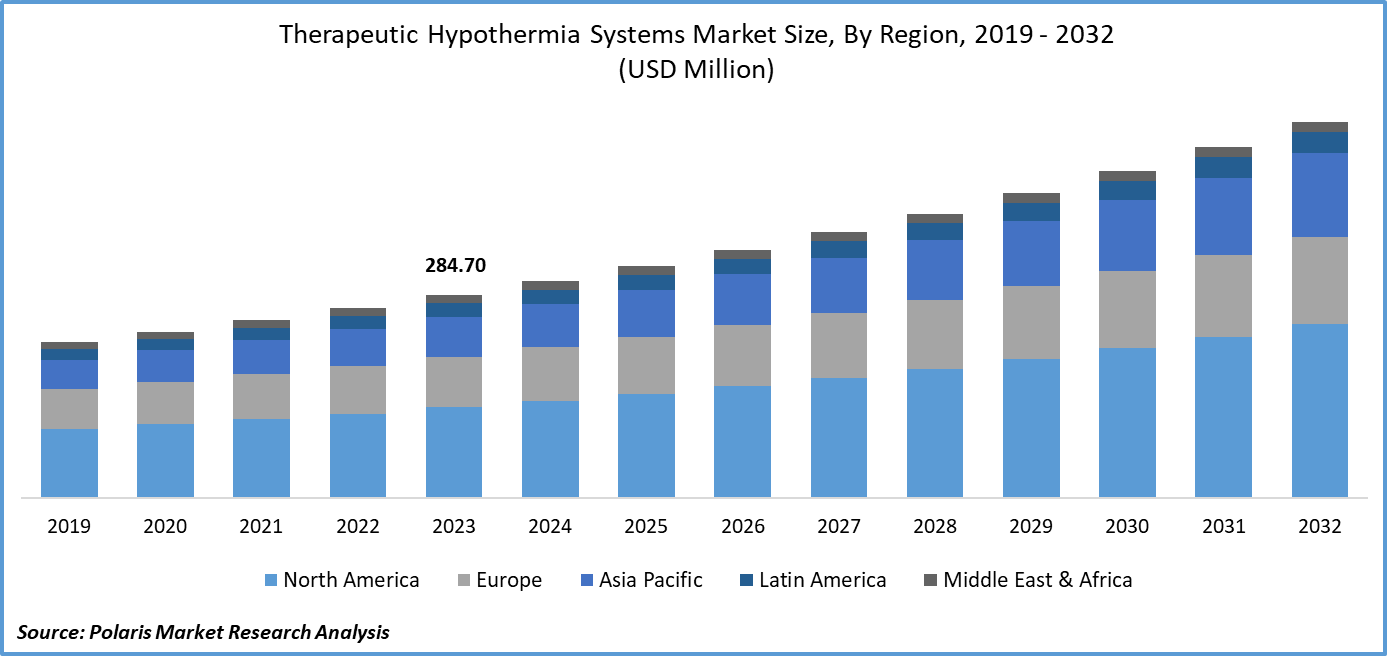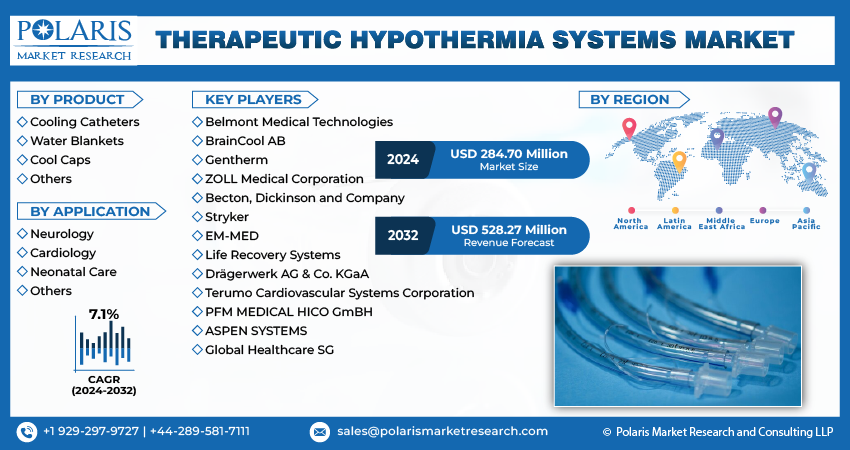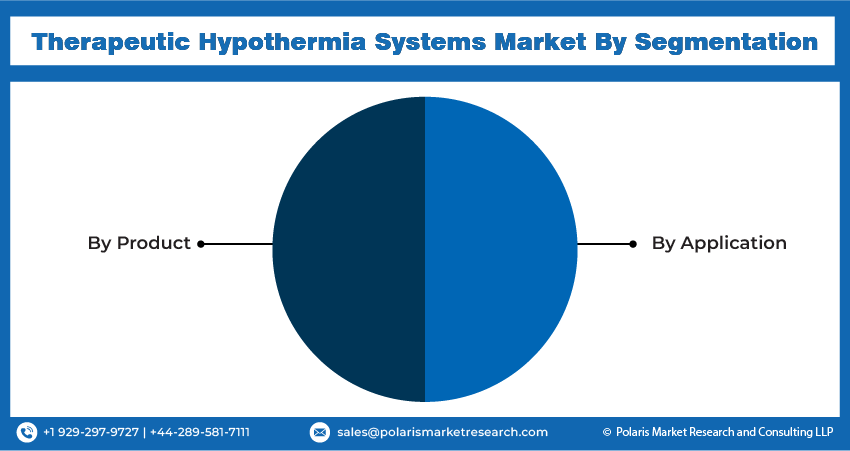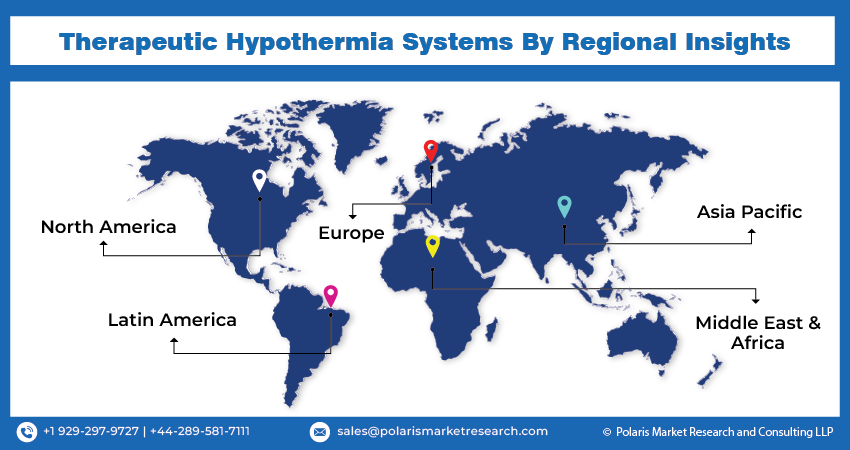
Therapeutic Hypothermia Systems Market Share, Size, Trends, & Industry Analysis Report
By Product (Cooling Catheters, Water Blankets, Cool Caps, Others); By Application; By Region; Segment Forecast, 2025 - 2034
- Published Date:Aug-2025
- Pages: 130
- Format: PDF
- Report ID: PM4406
- Base Year: 2024
- Historical Data: 2020 - 2023
The Therapeutic Hypothermia Systems Market is expected to reach USD 322.3 million in 2024, expanding at a CAGR of 8.2% through 2034. Increased incidence of cardiac arrest, neonatal encephalopathy, and the adoption of advanced temperature management systems are boosting market growth.
Industry Trends
Therapeutic hypothermia systems are medical devices used to induce therapeutic hypothermia, a state of deliberately lowered body temperature, typically between 32°C and 34°C (90°F-95°F), for the treatment of various medical conditions. These systems are designed to cool the body using a controlled method, such as circulating cold water or air through a blanket or pad, to prevent overcooling and maintain a stable body temperature. The goal of therapeutic hypothermia is to slow down metabolism and reduce inflammation, which can help protect the brain and other vital organs from damage caused by injury or disease.
The global therapeutic hypothermia systems industry outlook is expected to experience significant growth in the coming years, owing to the increasing incidence of cardiovascular diseases, such as myocardial infarction (MI) and cardiac arrest, which are leading causes of death worldwide. Therapeutic hypothermia has been shown to improve outcomes in patients who have suffered from these conditions, making it an attractive treatment option for clinicians and hospitals. In addition, advances in medical technology and the development of new cooling methods have made therapeutic hypothermia more accessible and easier to administer, further driving demand for these systems.

To Understand More About this Research: Request a Free Sample Report
However, the lack of availability and accessibility of these systems in certain regions are hindering the market growth. Also, the high costs associated with the purchase and maintenance of therapeutic hypothermia equipment can make it difficult for hospitals and clinics to invest in these systems. Despite these challenges, the global therapeutic hypothermia systems market trends are expected to rise, driven by the growing demand for effective treatments for cardiovascular disease and the expanding availability of these systems in emerging markets.
Key Takeaways
- North America dominated the market and contributed over 37% of the share of the total therapeutic hypothermia systems market size in 2024
- By product category, the water blankets segment is experiencing substantial growth over the therapeutic hypothermia systems market forecast to 2024
- By application category, the neurology segment accounted for the largest therapeutic hypothermia systems market share in 2024
What are the market drivers driving the demand for therapeutic hypothermia systems market?
The growing acceptance of therapeutic hypothermia and temperature management within the medical community to achieve neuroprotection and cardioprotection
The increasing recognition of therapeutic hypothermia and temperature management as a viable method for achieving neuroprotection and cardioprotection has been a significant driver of market growth. Therapeutic hypothermia, also known as induced hypothermia or targeted temperature management, is a medical technique that involves cooling the body to a specific temperature range to prevent or reduce tissue damage caused by various injuries or diseases. The growing acceptance of this technique within the medical community has led to an increased demand for therapeutic hypothermia systems, which are designed to safely and effectively control the patient's body temperature during treatment. The mounting evidence of the benefits of therapeutic hypothermia in treating conditions such as traumatic brain injury, stroke, cardiac arrest, and other critical care conditions fuels this demand.
As more healthcare professionals adopt this approach, the need for reliable and efficient therapeutic hypothermia systems is expected to continue to grow, driving the development of new technologies and innovations in the field.

Which factor is restraining the demand for therapeutic hypothermia systems?
Potential side effects of targeted temperature management are hindering the therapeutic hypothermia systems market growth.
The potential side effects of targeted temperature management, such as hypotension, bradycardia, and arrhythmias, can be a significant restraining factor for the market. These side effects can occur when the body's core temperature is lowered or increased too quickly or to an unsafe level, which can lead to serious complications or even death. As a result, healthcare providers might hesitate to adopt therapeutic hypothermia systems, especially in patients with pre-existing cardiovascular conditions. Moreover, the occurrence of these side effects also increases the cost of treatment, as patients require additional medical interventions to manage them, which negatively impacts the overall cost-effectiveness of therapeutic hypothermia systems.
Therefore, the potential side effects of targeted temperature management are a significant challenge that needs to be addressed by manufacturers and healthcare providers to ensure the safe and effective use of therapeutic hypothermia systems.
Report Segmentation
The market is primarily segmented based on product, application, and region.
|
By Product |
By Application |
By Region |
|
|
|
To Understand the Scope of this Report: Speak to Analyst
Category Wise Insights
By Product Insights
Based on product analysis, the market is segmented on the basis of cooling catheters, water blankets, cool caps, and others. The water blankets segment is expected to experience substantial growth in the market during the forecast period due to their ease of use, cost-effectiveness, and versatility. Water blankets are an effective alternative to traditional cooling methods, which can be inconvenient and require extensive preparation. They provide consistent and controlled cooling, allowing for precise temperature regulation and minimizing the risk of overcooling or undercooling.
- For instance, PlastiPad, a reusable water blanket used for heating or cooling the patient. It resists puncture and has good strength that helps extend the life of the blankets.
Additionally, water blankets can be easily adjusted to accommodate different body sizes and shapes, making them suitable for a wide range of patients, including neonates, children, and adults. Water blankets are relatively lightweight and portable, enabling healthcare professionals to transport them easily between hospitals or use them in emergency medical services.
By Application Insights
Based on application analysis, the market has been segmented on the basis of neurology, cardiology, neonatal care, and others. The neurology segment held the largest therapeutic hypothermia systems market share in 2023, owing to its extensive use in treating various neurological disorders such as stroke, traumatic brain injury, and spinal cord injury. Therapeutic hypothermia is widely used in neurology as a treatment option for post-resuscitation care after cardiac arrest, where the patient's body temperature is lowered to slow down the metabolic rate and prevent further damage to the brain tissue.
Further, the increasing incidence of stroke and traumatic brain injuries has led to an increased demand for therapeutic hypothermia systems in the neurology segment. The development of advanced cooling technologies that can quickly and effectively cool the body has made therapeutic hypothermia more accessible and convenient for clinicians, thereby contributing to the dominance of this segment.

Regional Insights
North America
The North American region dominated the global therapeutic hypothermia systems market share in 2023 owing to the increasing prevalence of cardiovascular diseases, such as myocardial infarction and cardiac arrest, which are leading causes of death in the region. Therapeutic hypothermia has been shown to improve outcomes for patients who have suffered from these conditions, making it an attractive treatment option for clinicians and hospitals. In addition, the presence of well-established healthcare infrastructure, advanced medical facilities, and favorable reimbursement policies in North America contribute to the high adoption rate of therapeutic hypothermia systems in the region.
Asia Pacific
The Asia Pacific region is expected to experience significant growth in the global market over the forecast period, driven by the increasing incidence of cardiovascular diseases, stroke, and traumatic brain injuries, which are among the primary indications for therapeutic hypothermia treatment. In parallel, the growing awareness about the benefits of therapeutic hypothermia in preventing mortality and morbidity associated with these conditions has led to an increased demand for such systems in hospitals and clinics across the region. Also, governments in countries like China, Japan, and South Korea have implemented favorable healthcare reforms and initiatives to improve patient access to advanced medical technologies, including therapeutic hypothermia systems.

Competitive Landscape
The key players are primarily focused on developing and commercializing advanced cooling technologies to treat various medical conditions. Additionally, they engage in strategic partnerships and collaborations with healthcare providers, distributors, and other players to expand their customer base and increase awareness about the benefits of therapeutic hypothermia.
Some of the major players operating in the global market include:
- Belmont Medical Technologies
- BrainCool AB
- Gentherm
- ZOLL Medical Corporation
- Becton, Dickinson and Company
- Stryker
- EM-MED
- Life Recovery Systems
- Drägerwerk AG & Co. KGaA
- Terumo Cardiovascular Systems Corporation
- PFM MEDICAL HICO GmBH
- ASPEN SYSTEMS
- Global Healthcare SG
Recent Developments
- In Mid-2025 – Pluss Advanced Technologies launches the MiraCradle® Neonate Cooler in India
- In June 2023, ZOLL, an Asahi Kasei company that manufactures medical devices and related software solutions, announced that it has entered into an agreement with BrainCool, a medical device company specializing in temperature management solutions, for the exclusive distribution of the BrainCool System/IQool System and the IQool System Pads in the U.S. and key markets in Europe.
- In August 2022, Gentherm Incorporated acquired Jiangmen Dacheng Medical Equipment Co. Ltd. for USD 37.3 million.
- In August 2021, ZOLLMedical Corporation and Wallaby Medical Technologies, a medical device company dedicated to treating stroke, announced the signing of a distribution agreement in which Wallaby is managing the sales and distribution of ZOLL's temperature management products in China.
Report Coverage
The Therapeutic Hypothermia Systems market growth report emphasizes key regions across the globe to provide a better understanding of the product to the users. Also, the report provides market insights into recent developments and trends and analyzes the technologies that are gaining traction around the globe. Furthermore, the report covers an in-depth qualitative analysis pertaining to various paradigm shifts associated with the transformation of these solutions.
The report provides a detailed analysis of the market while focusing on various key aspects such as competitive analysis, product, application, and futuristic growth opportunities.
Therapeutic Hypothermia Systems Market Report Scope
|
Report Attributes |
Details |
|
Market size value in 2025 |
USD 395.7 million |
|
Revenue Forecast in 2034 |
USD 684.7 million |
|
CAGR |
8.20% from 2025 – 2034 |
|
Base year |
2024 |
|
Historical data |
2020 – 2023 |
|
Forecast period |
2025 – 2034 |
|
Quantitative units |
Revenue in USD million and CAGR from 2025 to 2034 |
|
Segments Covered |
By Product, By Application, By Region |
|
Regional scope |
North America, Europe, Asia Pacific, Latin America; Middle East & Africa |
|
Customization |
Report customization as per your requirements with respect to countries, regions, and segmentation. |
Explore the 2025 market share, size, and revenue growth rate statistics in the field of Therapeutic Hypothermia Systems Market, meticulously compiled by Polaris Market Research Industry Reports. This comprehensive analysis encompasses a market forecast outlook extending to 2034, along with an insightful historical overview. Experience the depth of this industry analysis by obtaining a complimentary PDF download of the sample report.
Browse Our Top Selling Reports:
Complementary and Alternative Medicine for Anti-Aging & Longevity Market Size, Share 2024 Report
Corn Market Size, Share 2024 Report
gRNA Market Size, Share 2024 Report
FAQ's
The global therapeutic hypothermia systems market size is expected to reach USD 684.7 Million by 2034
Key players in the market are Belmont Medical Technologies, BrainCool AB, Gentherm, ZOLL Medical Corporation, Becton
North American contribute notably towards the global Therapeutic Hypothermia Systems Market
Therapeutic Hypothermia Systems Market exhibiting a CAGR of 8.20% during the forecast period
The Therapeutic Hypothermia Systems Market report covering key segments are product, application, and region.
